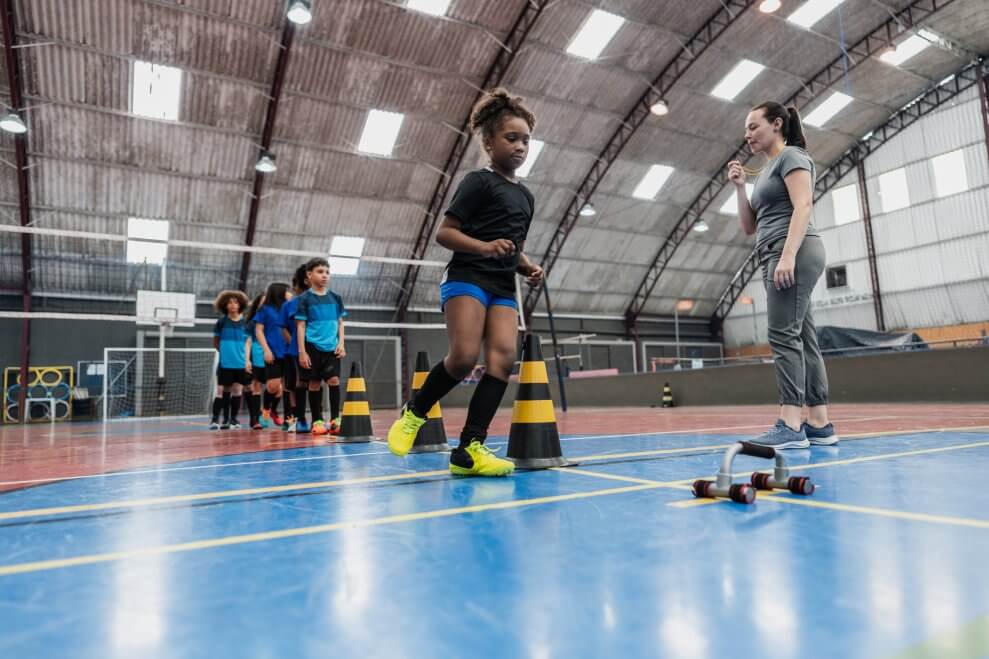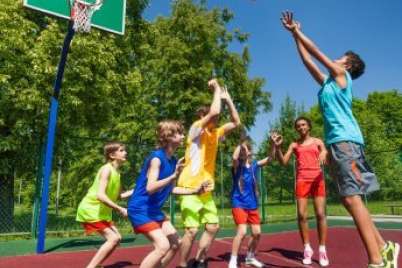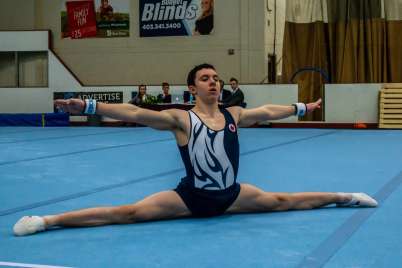
What parents should know about kids’ sports injuries
“Mom, my knee is sore,” my son announced casually as I was driving him home from practice.
“Sore?” I asked. “When did it start? How sore is it? Where does it hurt? Do you want me to book an appointment to see the physiotherapist?”
“It just started feeling sore yesterday. Let me see how it feels during training tomorrow.”
I gave him a sidelong glance and nodded. My 16-year-old knows the drill. In our home, we take sports injuries seriously. There’s no “pushing through the pain” or “waiting to see” if it gets better. We’ve learned from experience that ignoring injuries can result in serious setbacks both in the short- and long- term.
It’s my hope to save you and your child some pain (pun intended) by sharing what I’ve learned about sports injuries over the last 16 years while raising my own five kids. In this article, I’ll share an overview of the common types of sports injuries kids get and why they happen, and then offer some useful tips for helping your kids avoid them.
What are some common sports injuries?
When kids play sports, injuries happen. Thankfully, most of these injuries are minor and will heal quickly, like scraped knees and bruises. Other times, however, injuries can be more serious. When it comes to sports injuries, there are two broad categories: acute injuries and chronic (overuse) injuries. Acute injuries happen suddenly, like a broken bone or an ankle sprain. Chronic injuries happen over longer periods of time, like shin splints or stress fractures. Both types of injuries can be serious.
Here’s a quick list of the most common sports injuries kids experience.
- Bone fractures
- Head and neck (concussions, mild traumatic brain injuries, whiplash)
- Ankle sprains
- Wrist injuries (falling on an outstretched hand)
- Elbow and shoulder injuries (Little League shoulder/elbow, dislocated elbow)
- Shin splints
- Knee injuries (ACL tears, meniscus injury)
- Back injuries
A note about concussions (mild traumatic brain injuries): Kids who play team sports like football, rugby, soccer, hockey, baseball, and basketball are at risk of getting hit or colliding with other players. These impacts really hurt, but sometimes in ways that aren’t visible. Concussions, also called mild traumatic brain injuries (mTBI), are no joke. While most children recover from mild concussions, some will go on to have lasting side effects. According to the 2019 Canadian Health Survey on Children and Youth, the most common type of injury among the injuries surveyed was head injuries or concussions, with sports being the leading cause. As a parent, knowing about concussions and what to look for is very important. Parachute Canada has a lot of helpful information, including the signs and symptoms of a concussion.

Why do sports injuries happen to kids?
According to Statistics Canada, two–thirds (66%) of injuries among young people (aged 12 to 19) were related to sports, which is twice as high as working-age adults (29%). Why do kids get so many sports injuries? For one, kids play a lot of sports! A recent report found that 67% of children and youth (ages three to 17) participate in a sport, and that’s great. When kids play sports, they’re learning how to move their bodies in fun and challenging ways while developing coordination, balance, and muscle strength. We sometimes forget, however, that childhood is a time of growth and development, making kids more at risk for sports injuries.
Bones
Let’s talk about bones. According to a Canadian study, bone breaks are one of the most common types of sports injuries in Canada. Children’s longer bones have open growth plates so they can grow. These growth plates are made of a softer material (cartilage) that can get injured more easily than regular bone. Bones can also cause other problems during growth. When bones go through major growth spurts, especially around puberty, muscles and ligaments must play catch up. This makes kids more at risk for getting sports injuries. That’s exactly why my son’s knee started hurting. He had gone through a huge growth spurt and the muscles and ligaments were having a hard time stabilizing his knee properly.
Brains
Physically speaking, children’s heads and brains grow and develop in significant ways until adulthood. Children’s heads are bigger in proportion to their bodies, their skulls are thinner, and their neck muscles are weaker. Children’s brains are also making connections and learning, figuring out complex movement skills, and learning how to assess situations. All these things make kids more susceptible to sports injuries. Younger children are more likely to fumble and have accidents while older kids, especially those in contact sports, are at greater risk for brain injuries.
External factors
While children’s growing bodies put them at greater risk for sports injuries, there are some external factors that have an impact too. The growing trend towards early sport specialization gets kids hyper-focused on a specific movement, putting them at greater risk for overuse injuries. Overuse injuries happen when kids experience “wear and tear” on their growing bones, ligaments, and muscles. Other external factors that cause sport injuries for kids include not warming up properly, using poor technique, and wearing poorly fitted gear.
How to help kids prevent sports injuries
Playing sports has many benefits for kids and can help them be active for life! Injuries do happen, but there are things you can do to help your kids experience the fun of sports while minimizing the injuries.
Talk to your kids about sports injuries
In our home, we talk about sports injuries a lot, especially now that I have teens who are specializing in sports. While I drive my kids home from practice, I do a check-in. This is important, since most sports injuries happen during practice. Typically, I ask my kids: How was practice today? What did you work on? How is your body feeling? How are you feeling emotionally? These questions help kids develop self-awareness and increase their ability to notice when something’s off early on.
Talk to the coach(es) about sports injuries
Around the age of 10, my daughter developed shin splints while dancing. To my surprise, her coach didn’t know about this common dance overuse injury (red flag!). Since then, I’ve had open conversations with my kids’ coaches about sports injuries. Typically, I ask coaches: How do you help prevent injuries with young athletes? What training do you have for dealing with accidental injuries? What potential chronic injuries can happen in this sport? These questions open the line of communication between parents, coaches, and kids when it comes to injury prevention or managing injuries if they do happen.

Hold off on early sports specialization
Getting an early intensive start in a single sport puts kids at a higher risk of overuse injuries. Because of this risk, experts recommend a multisport approach so that younger children have a whole-body foundation in movement skills. If you’re looking for specific guidelines, on page 25 of this document, Sport for Life [PDF] recommends that children between the ages of six to nine focus on the FUNdamentals: activities that develop the ABCs (agility, balance, coordination, and speed) of movement, such as running, jumping, throwing, and swimming—with an emphasis on keeping it FUN! However, if your child insists on focusing on one sport, here are a few principles to follow to prevent injuries.
Play outside (a lot!)
Unstructured outdoor play can help children practice a range of movement skills and protect against chronic sports injuries. Interestingly, chronic sports injuries don’t show up in kids who play outside a lot because children move their bodies in diverse ways. Outdoor play also has a load of other benefits for kids, such as building healthy brains, managing emotions, and improving academic success.
Insist on hydration, healthy eating, and rest
Drinking enough water, eating healthy foods, and sleeping well are three pillars that help kids prevent sports injuries. Taking complete breaks from sports is also important. Children should have two days off from playing sports each week and longer breaks of one to three months if they’re in intense competitive sports. This doesn’t mean kids should sit around and do nothing while resting. They can still be active but should rest from intensive repetitive motions. This prevents burnout and chronic injuries.
Warm up, wear the right gear, and move well
Taking the time to warm up before practices and games helps prevent sports injuries. So does wearing the right, properly fitting gear. Often when gear is purchased second-hand or passed down from one child to the next, it isn’t properly fitted. Ensure gear fits well and is in good working order by asking a coach to assess your child’s gear. Using the right technique is also key to preventing injuries, and parents should be on the lookout for fatigue, which causes technique to break down.
Provide support when injuries happen
When injuries happen, respond immediately. If the injury is acute, have your child stop doing the activity immediately and get treatment. Don’t ignore early signs of overuse injuries either. A niggling pain can quickly become a big issue if overlooked. Bring your child to a physiotherapist or doctor to get assessed and to determine your treatment options, such as physical therapy. Be proactive! Also, keep in mind that sport injuries can be challenging for children to navigate mentally and emotionally. This struggle can be even more apparent with older kids who tie their identity with a particular sport. Supporting children physically, mentally, and emotionally will help them return to sports injury-free and stronger than before.
Sports are great for kids. They encourage physical activity, develop movement skills, build self-esteem, and more. However, sports can lead to injuries. Thankfully most injuries are mild, but serious injuries can happen. By being proactive, many of these injuries can be avoided and children can enjoy sports for life!





